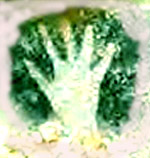 Introduction to Archaeology
and Palaeoanthropology:
Introduction to Archaeology
and Palaeoanthropology:
 Introduction to Archaeology
and Palaeoanthropology:
Introduction to Archaeology
and Palaeoanthropology:
Humanity's Journeys
Dr. Kathryn Denning
Anth 2140, Sept 2006 - Apr 2007
17 Oct 2006... Welcome!
Plan for class
1) Announcements
2) Evolutionary mechanisms and principles
3) Macroevolution / the story of life on Earth... including video segment from Extinction!
Announcements:
Information about Assignment 1, due in tutorial on Oct 25 -- Handouts available from your TAs, and online.
Reading assignment for next week
Tomorrow in tutorial: watch video segment on Extinction! and discuss
Cells/DNA/heredity:
So how do our cells work, and how does biological inheritance work?
Bottom Line: It's not magic : )
The Eukaryotic Cell

Chromosomes and DNA
Nuclear DNA
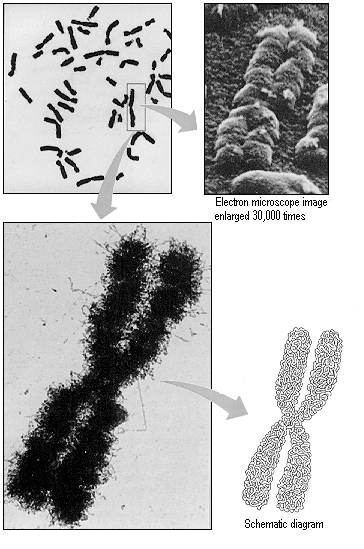
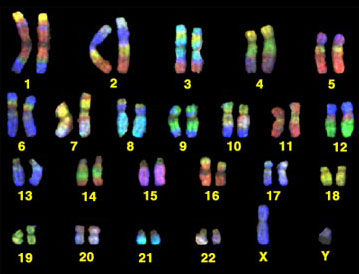

Left - actual scanning electron microscope photograph of human chromosomes, with false colour (by Andrew Syred)
Right - human karyotype, false colour
The Mitochondrion
- an organelle known as "The Powerhouse" of the cell.
- plural "mitochondria"
The Endosymbiont Theory of how mitochondria became part of eukaryotic cells.... i.e. that mitochondria were once free-living little bacteria which began to live inside larger cells ... explains why mitochondria still have their own division cycle, and thus why mtDNA replicates separately from the nuclear DNA of the eukaryotic cell.
Human Mitochondrial DNA is -- like most bacterial/prokaryote DNA -- organized in a closed circle (below left), unlike Human Nuclear DNA, which is in a double helix (below right).
Human mitochondrial DNA genome has 37 genes. Human nuclear DNA has 46 chromosomes (23 pairs) and about 30 000 genes.

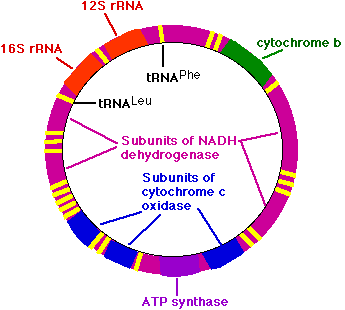
Recall that
a) Normal human somatic (body) cells have 22 pairs of autosomes (ordinary chromosomes) and one pair of sex chromosomes. Somatic cells go through the process of mitosis: one cell with 46 single-stranded chromosomes becomes one cell with 46 double-stranded chromosomes, then divides into two identical cells, each of which has 46 single-stranded chromosomes.
b) Gametes (sex cells, egg and sperm) are created via meiosis, which occurs in the ovaries and testes. The first stage of meiosis is just like mitosis. Then the cells divide again.... resulting in four cells with with 23 single-stranded chromosomes. Crucial: in meiosis, there is mixing of genetic material between partner chromosomes, which contributes to genetic variation in a population. And it is meiosis that ensures that you get only one sex chromosome (X or Y) from each parent -- X from mother or father, Y only from father.
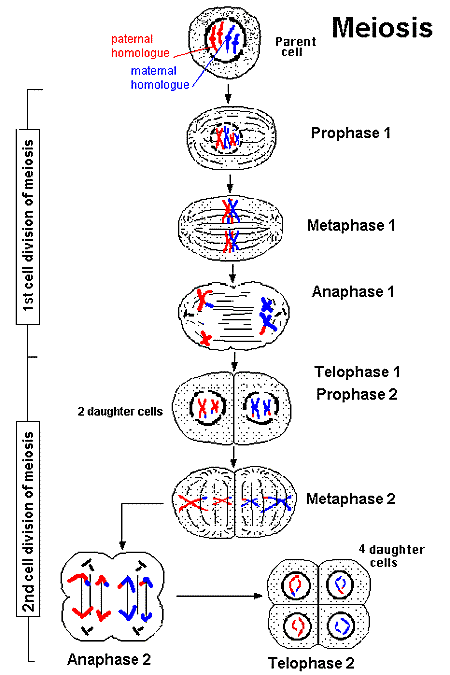
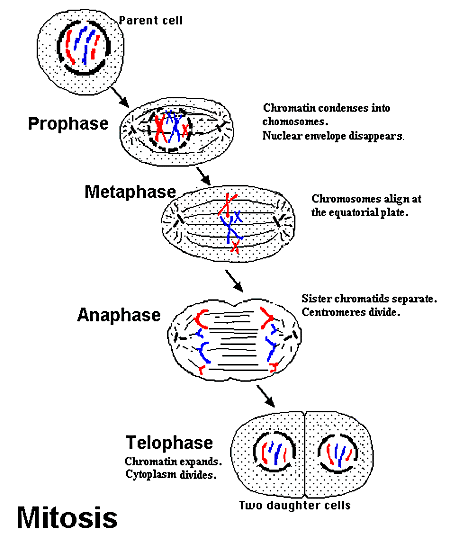
Important facts about mtDNA:
- as a rule, mammals inherit mitochondria only from their mother... though a few paternal mitochondria do get from the sperm into the egg during the process of fertilization, they are generally destroyed quickly www.sciencenews.org/articles/20000101/fob3.asp
- there is a bit of gene-swapping occasionally between mitochondria and the nucleus -- DNA moves around rather more than was once believed (and chromosomes are also quite messy, i.e. there are many non-functioning DNA segments there)
- mitochondrial DNA mutates/evolves quickly compared to nuclear DNA... and at a relatively stable rate. This, coupled with the fact that you inherit mtDNA only from your mother, makes the mitochondrial molecular clock possible.... although there's a lot of dispute about finetuning the clock! (more on this later)
Y chromosomes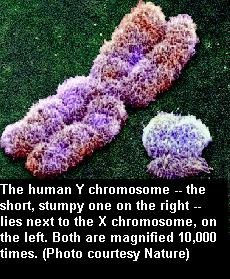
- remember that... generally, males have X and Y chromosomes, while females have only X and X
- so... Y chromosomes come only from the father, via sperm
- thus Y chromosomes are useful for tracing paternal inheritance, much as mitochondria are useful for tracing maternal inheritance
- X chromosomes can also be used, but an individual's X chromosome(s) can come from the father or mother -- so there's no real advantage to that
- nuclear DNA is really hard to use for tracing evolutionary change because it gets shuffled around so much from generation to generation
Different forms of Genetic Inheritance
Recall that for all genes (except those on X and Y chromosomes), you have TWO copies -- one from your mother and one from your father. For some genes, there are different versions -- alleles -- with slightly different instructions for the cell. Maybe you'll have two alleles that are the same. Maybe you'll have two alleles that are different -- and in that case, which version will your body listen to?
Mendelian Inheritance:
Some traits in the body are determined by only one genetic locus. (simple inheritance or Mendelian traits). These may have multiple alleles, however.
Allele = alternate forms of a gene (flavours)
'Dominant' allele = expressed no matter what
'Recessive' allele = not expressed in the presence of a dominant allele. Need two copies for a recessive allele to be expressed.
genotype: genetic makeup of an individual
phenotype: observable physical characteristics of an individual -- the expression of a genotype
homozygous: have two copies of same allele of a gene
heterozygous: has two different alleles of a gene
Example of Mendelian inheritance in humans: ABO blood system

So... A and B are codominant
A is dominant to O
B is dominant to O
But your phenotypic blood type is clearly one type or another. It's not 40% O and 55% A with a little B mixed in.
Mendelian traits are discontinuous in their distribution.

Lots of interesting variation, including many medical conditions, are caused by straightforward Mendelian Inheritance
Online Mendelian Inheritance in Man http://www.ncbi.nlm.nih.gov/entrez/query.fcgi?db=OMIM
Remember that natural selection acts on the PHENOTYPE, not the genotype. This is why a detrimental recessive trait can stay in the population and not be selected out. ("Carriers" have one recessive allele.)
(Some recessive alleles can exert an influence on the phenotype, but it is usually not strong.)
Polygenic Inheritance
Many, many phenotypic traits are determined by multiple genes acting together (polygenic), rather than by a single gene (Mendelian). This results in a range of expressions.
e.g. not merely dark brown or pale pink, but many shades in between
e.g. not merely two different heights of humans, but many
Polygenic traits have a continuous distribution.
 Polygenic traits in humans,
generally speaking, include skin colour, hair colour, stature, eye colour, face
shape, nose shape, fingerprint pattern.
Polygenic traits in humans,
generally speaking, include skin colour, hair colour, stature, eye colour, face
shape, nose shape, fingerprint pattern.
Do Genes Determine Everything?
Certainly not. The genotype does not absolutely determine the phenotype.
Environment plays a substantial role in how genes are expressed. (e.g. nutrition and stature)
OVERALL... much is still being learned about genetics -- it is not as simple as we once thought -- but the principles above are generally true.
Often, evolution is not totally straightforward in practice....
One example in humans: Malaria and sickle-cell anemia. But n.b. this is actually a balanced polymorphism, where natural selection is working in two opposite directions at once, which holds the different allele frequencies in balance... instead of gradually eliminating one

Normal red blood cells and a sickle cell.
Hemoglobin molecules in the red blood cells carry oxygen to the body's tissues.
Alleles for hemoglobin:
Hb(n) = normal Hb --> normal cells
Hb(s) = hemoglobin that doesn't carry as much oxygen, and which crystallizes inside the red blood cell, causing it to become sickle-shaped. These sickled cells are fragile, can't carry much oxygen, and can't get down the tiny capillary blood vessels to the body's tissues.... resulting in pain, anemia, general disability, and if left untreated, early death.
Note: these alleles are BOTH expressed (one is not dominant to the other)
If a person has one copy of Hb(s), they can be quite fine.
If they have two copies of Hb(s), they are usually very ill.
So why hasn't the gene for sickle cell simply vanished over time due to natural selection working against it?
Because in one circumstance, it's actually an ADVANTAGE to have one copy of Hb(s): in areas with a high prevalence of malaria.
The malaria parasite (a protozooan, genus Plasmodium) is transmitted by mosquitoes, and lives in the red blood cells, where it obtains the oxygen that it needs to live.
Malaria can be fatal, and often hits children (i.e. before reproductive age).
The Plasmodium can't live in sickle cells! So... if you have some sickled cells... your malaria infection isn't as bad as if you have all normal red blood cells!
So the effects of sickle cell anemia push the population's Hb alleles in one direction, while the effects of malaria push the population's Hb alleles in the other direction.
EVOLUTIONARY CHANGE
Be aware that 'survival of the fittest' is a a short-hand term that can make evolution seem much more simple than it is! Fitness is always relative to the environment... which is always changing.
examples: .... armadillos, skunks, opossums, fainting goats/myotonic goats (recessive)
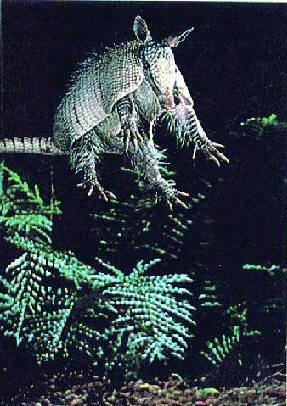
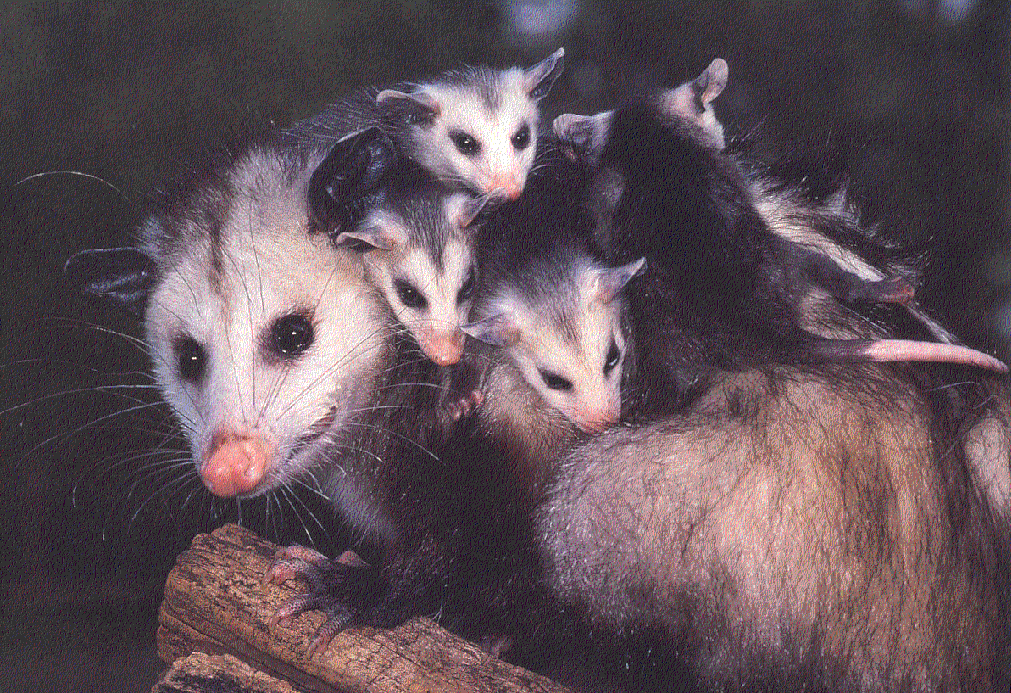

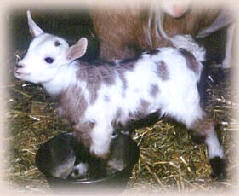
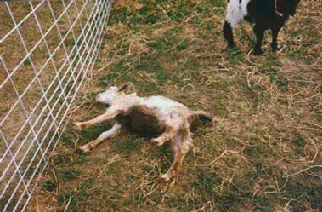
Note! Natural selection is only one form of selective pressure in evolution.
Evolution: A change in the frequency of alleles from one generation to the next
Evolution is the result of
a) the production and redistribution of variation (inherited differences between individuals)
e.g. production of variation via mutation (novel arrangements of DNA). Mutation and recombination provide the variability on which selection works. n.b. Mutations take place all the time, but to have an effect on a population/evolution, they must occur in the SEX CELLS / gametes... and be survivable.
e.g. redistribution of variation via gene flow, or mating between different populations of the same species
e.g. genetic recombination via meiosis, which shuffles the combinations
e.g. redistribution/reduction of variation via genetic drift (including founder effect)... many significant examples in human microevolution
b) natural selection acting on this variation (because inherited differences among individuals differentially affect their ability to reproduce successfully)
Natural selection in action
* peppered moths and industrial melanism near Manchester: the population overall getting darker or lighter, in response to tree bark getting darker or lighter from coal dust (predation worse for the moths that don't blend in)
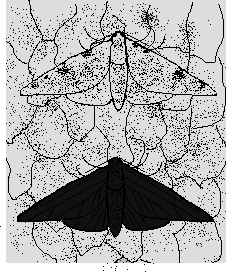
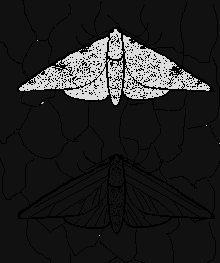
* antibiotic-resistant strains of pathogenic micro-organisms. In each generation of bacteria, the ones that survive are the ones that reproduce. The bacteria that are resistant to antibiotics are the ones that make more bacteria.... which in turn are resistant to antibiotics.... n.b. evolution in bacteria is fast because of short generation time and because they swap genes with other bacteria.
* And beak size changes in "Darwin's finches" have been observed recently -- correlation to climate
Natural selection concerns survival. But you also have to reproduce ... So another important force is sexual selection, whereby there is competition for mates, and certain traits become favoured. (e.g. big antlers, pretty feathers) These traits may have little or nothing to do with direct survival -- and may even work against survival! -- but everything to do with whether an individual has the chance to mate or not. Sexual selection can be a very strong force within a species (sometimes even stronger than natural selection).
Speciation
Lots of different ways of considering 'species', but the basic concept is that different species cannot interbreed and produce fertile offspring.
(Odd exceptions... e.g. a wholphin, cattolo, rare mules... but the general concept stands)
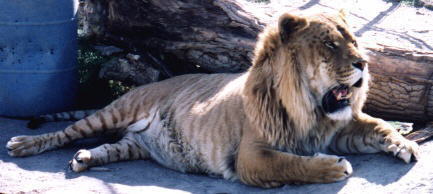
(liger - hybrid)
A population can split into species due to geography (e.g. separation by a river or mountain range, isolation on an island), or due to changes in behaviour (e.g. mating songs not mutually recognized).
For humans:
We are all one species, i.e. can interbreed and produce fertile offspring.
A key concept in human evolution is "chronospecies" - we assume that if a human ancestor was *quite* different from ourselves that we would not be able to interbreed... and we give it a different species name.
e.g. Homo erectus.
Sometimes we're not quite certain - e.g. Neanderthals. Some anthropologists call them
Homo neanderthalensis (a separate species)
and others call them
Homo sapiens neanderthalensis (same species, different subspecies)
SPECIAL NOTE:
New and surprising things are being discovered all the time in the world of biology, evolution, and genetics. And old finds are constantly being reanalyzed with new techniques, which leads to new discoveries.
e.g.
http://news.bbc.co.uk/2/hi/science/nature/6048186.stm?ls
http://news.bbc.co.uk/2/hi/science/nature/5036618.stm
http://news.bbc.co.uk/2/hi/science/nature/6043648.stm?ls
http://www.nature.com/news/2006/061009/pf/061009-7_pf.html
http://www.nature.com/news/2006/061009/pf/061009-14_pf.html
Macroevolution / the story of life on Earth
How does it all work??
Key Points from Stephen Jay Gould's article (which was assigned reading for this week)
http://www.brembs.net/gould.html
Natural selection doesn't explain the full sweep of evolution. It explains some of it.
Punctuated equilibrium: dramatic events in Earth's history have sometimes wiped out many species completely -- without regard for how well-adapted they were.
Contingency - chance - is important in macroevolution.

n.b. "Progress" does not rule, i.e. not all life is getting more complex all the time. Bacteria rule. "The number of Escherichia coli cells in the gut of each human being exceeds the number of humans that has ever lived on this planet." And life was "almost exclusively unicellular for the first five-sixths of its history".

The tree of life looks like this -- many branches have been lopped off. We humans are one twig on one branch. We are the last of our genus -- arguably, not particularly successful.
Human beings are the result not only of natural selection, but of many coincidences/fortuitous events. e.g.
1) our very distant ancestors survived
the extinctions at the end of the Cambrian (so many did not... e.g.
Burgess Shale) - survivor: the chordate Pikaia
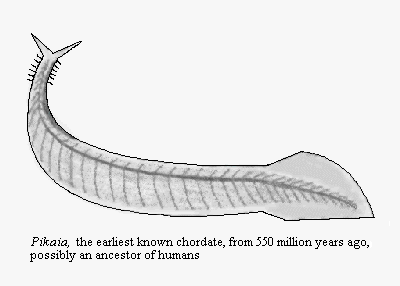 (chordates gave rise to
vertebrates)
(chordates gave rise to
vertebrates)
2) lobe-finned fishes developed stiff enough fins to walk a bit on land - terrestriality
3) dinosaurs became extinct, clearing the way for early mammals to thrive
4) our primate ancestors became bipedal
BOTTOM LINE: IT DIDN'T HAVE TO BE THAT WAY
Locating ourselves in time
See handout.
What are the key dates for biological evolution? (All dates are approximate!)
|
1 |
2 |
3 |
4 |
|
|
Date on a one-year calendar[1] |
Actual Date[2] |
What was new? |
Notes on Extinctions etc. in terms of Geological periods |
GEOLOGICAL PERIODS Only start date is given. Dates are approximate. |
|
Jan 1 |
15 bya |
the universe formed |
|
PRECAMBRIAN |
|
Sept 24 |
4.5 bya |
Earth formed |
|
|
|
Sept 25 |
4 bya |
bacteria appeared |
|
|
|
Nov 15 |
1.7 bya |
multicellular organisms appeared |
|
|
|
Dec 17 |
570 mya
|
complex organisms, jellyfish, worms, invertebrates |
Explosion of biodiversity in Cambrian period |
CAMBRIAN 570 MYA |
|
Dec 19 |
510 mya |
fish, coral, vertebrates |
500 mya (late Cambrian) massive extinction. 440 mya (Ordovician), large extinction. |
ORDOVICIAN 500 MYA
|
|
Dec 21 |
425 mya |
land plants, insects, jawed fish, air-breathing animals first forests 395 mya |
Around 365 mya, Devonian extinction (70% of species lost) |
SILURIAN 430 MYA
DEVONIAN 395 MYA |
|
Dec 23 |
350 mya |
amphibians and reptiles (dinosaurs appeared 230 mya) mammal-like reptiles 280 mya egg-laying mammals 225 mya Great Age of Dinosaurs 190 mya toothed birds 190 mya |
Around 245 mya (end Permian extinction), 96% of all species eliminated, including 75% of all vertebrates Around 200 mya (late Triassic extinction) 25% of species eliminated |
CARBONIFEROUS 345 MYA PERMIAN 280 MYA TRIASSIC 225 MYA JURASSIC 190 MYA
|
|
Dec 25 |
150 mya |
lots of reptiles, fish, amphibians modern birds placental & marsupial mammals |
n.b. continents all one (Pangaea) until splits start ca. 200 mya |
CRETACEOUS 136 MYA |
|
Dec 26 |
65 mya
|
mammals (warm-blooded or homeothermic, i.e. able to regulate own body temperature, and live in more climates; increased investment in offspring; increased brain development) |
65 mya Cretaceous-Tertiary boundary (mass extinction, 85% of all species eliminated, including dinosaurs) |
TERTIARY 65 MYA Tertiary Epochs, below Paleocene 65mya
|
|
|
60 mya |
primates (more like prosimians) with grasping hands, opposable thumbs, stereoscopic vision, nails, collarbone, 1-2 offspring at a time |
Weather everywhere is tropical 40 mya: continents near present positions |
Eocene 55 mya Oligocene 34 mya |
|
Dec 29 |
35 mya |
monkeys and apes (anthropoids): flatter faces, nonmobile ears, very dextrous hands |
33 mya late Eocene extinction, loss of many mammals – global cooling |
Miocene 23 mya |
|
|
15 mya |
ape-like ancestors of humans (hominoids), e.g. Proconsul |
Miocene |
|
|
Dec 31, 10:30 pm |
4 mya |
human-like beings (hominids: Australopithecus afarensis and onwards to Homo): bipedal, bigger brain, reduction of face, teeth, jaws |
Pliocene |
Pliocene 5 mya Pleistocene 1.8 mya |
|
Dec 31 Stone tool use: 11:00:00 pm Agriculture: 11:59:20 Writing: 11:59:51 0 AD: 11:59:56 Now Nuclear weaponry, global culture, space travel |
100 000 ya
anatomically modern humans (Homo sapiens sapiens): larger brain, chin, smaller brow ridges, lighter skeleton, smaller teeth and jaws |
11 000 ya, substantial extinction of large mammals (climate change)
now – the sixth great extinction? |
Holocene 0.01 mya |
|
[1] This metaphor comes from Carl Sagan, Dragons of Eden, 1977 p15
[2] 1 billion = 1 000 000 000 1 million = 1 000 000 bya = billion years ago mya = million years ago
Watching part of....
Extinction! 60 minutes. 2001. York vid #6285 From the series Evolution, vol 3.
See handout.
Key Themes to Think About
- our place in evolutionary history
- the role of extinction (and subsequent diversification) in evolution – think about the role of chance/contingency in this… the times when habitat change is so profound that selection is utterly drastic, and even the well-adapted die out
- just because we’re alive today does not mean that we are better adapted than all previous life forms!
- n.b. not all mass extinctions are fully understood — we don’t know for sure what caused them (could be different causes in each case)
- ecosystems consist of interconnected species, or ‘houses of cards’, which can easily collapse
- recent human life on earth has had a huge impact upon the environment, through deliberate modification of landscape, pollution, domestication, and the introduction of invasive species… this is something that we see often in archaeology of past societies
- the icon of the tree representing the branching course of evolution
- see the way that evidence of the distant past is buried, in layers that may be below ground (Hawaii), or now exposed above ground (Karoo Desert)
- reading the fossil record is challenging, because that record is always incomplete (since not everything that lives and dies becomes a fossil)
BELOW: EXTRAS.... JUST IF YOU'RE INTERESTED...
-----------
Recent research from Nature
Published online: 15 October 2006; | doi:10.1038/news061009-14
A genetic switch that produces testes has been found.
|
|
|
|
|
|
|
The battle of the sexes continues to rage —
right down to the level of our genes.
A gene has now been discovered that, when
mutated, turns girls into boys. The finding advances, but also complicates, our
understanding of how sex is determined by our genes.
In people, almost all men carry two different
sex chromosomes (XY) and women are XX. But there are some (extremely rare)
exceptions to this rule. It is possible to have XX men, for example.
This female-to-male sex reversal almost always
happens when a certain gene called SRY, usually carried on the Y
chromosome, accidentally ends up on the X chromosome inherited from the father.
Other genes have been found to muddle up sexual
identity, making the resulting child neither fully male nor fully female. But in
most cases of anatomically complete XX men — who have functional testes, but
without a Y are infertile — SRY is involved. For this reason, it has long
been called the gene that defines 'maleness'.1
But now Giovanna Camerino of the University of
Pavia in Italy and colleagues have found another gene that is equally important
to the process.
In the family
The team studied a family in which four brothers
were each XX. None carried the 'male' SRY gene. Instead, the team reports
in Nature Genetics2,
they each have a mutation in a gene called RSPO1.
It seems that sex is determined in humans by a
cascade of genes. At a crucial junction in this process lies a gene called
SOX9, which in males is switched on by SRY, causing testis
development. In females, the researchers now suggest, SOX9 might be
typically switched off by RSPO1, which, via other genes in the cascade,
leads to the development of ovaries. In the brothers, it seems the mutated
RSPO1 gene could not fulfil its switching-off role, leaving SOX9 on
and leading to male development.
This theory fits with animal studies: mice with
two X chromosomes that have their SOX9 expression turned back on form
testes.3
Active turn on
The idea stands in contrast to previous theories
that said that female development was basically the default that happens in the
absence of genes to direct maleness. "What is really important is that
suppression of male and induction of female development is an active process,"
says Andreas Schedl of INSERM, the French National Institute of Health and
Medical Research in Nice, who is a co-author on the paper. "RSPO1 clearly
plays a key role in this process." The identification of this gene, he says, may
be as important to the field as the identification of SRY.
RSPO1 encodes for a protein that is
something of a multi-tasker — as well as being a key player in the
sex-determining pathway, it also causes all the males in this family to suffer
from a skin-thickening condition, and predisposes them to skin cancer.
Understanding how it does this might help researchers to confirm its exact role
in sex determination.
The next step, say the researchers, is to find
out what happens when the RSOP1 gene is knocked out of mice.
|
|
|
|
|
|
|
|
|
|
|
|
| References |
-------------
Published online: 11 October 2006; | doi:10.1038/news061009-7
Spanish rodents lived and died by changes in our orbit.
|
|
|
|
|
|
|
Can a tiny change to the Earth's orbit wipe
out life? New evidence suggests that perhaps it can — in Spanish rodents, at
least.
The Earth is well known to fluctuate in a number
of defined ways: its axis wobbles about; its tilt with respect to the Sun
changes; and the degree to which its orbit isn't circular varies too. These
astronomical forces, known collectively as Milankovitch oscillations, can affect
the climate on Earth by altering the amount of sunlight received by different
regions of the globe.
Whereas Milankovich oscillations normally
operate on a relatively short timescale of 20,000-400,000 years, the magnitude
of these cycles varies with lower frequency, over millions of years. It is
unclear whether these variations have affected life on Earth.
Previous work has suggested that life has been
remarkably resilient to climate change. "This has been a real controversial area
in our little world of palaeontology," says Anthony Barnosky of the University
of California, Berkeley.
Some have wondered whether previous studies
failed to spot die-offs associated with Milankovitch-linked oscillations because
they pooled data from different parts of the globe. "People look at it from a
whole bunch of different spatial and temporal scales," says Barnosky. "They may
lump together, say, Oregon and southern Utah, where climate changes might be
different."
|
|
|||
|
|
||||
Dental records
To get around this problem, Jan van Dam of
Utrecht University in the Netherlands and his colleagues examined an extensive
collection of 80,000 rodent teeth from central Spain. The fossils, collected
over 40 years of sifting through soil along riverbanks and construction sites,
range from 24.5 to 2.5 million years old.
The team mapped out which species lived in which
time periods. With this information, they found evidence for two different
cycles of die-offs, each taking up to 30% of the species alive at the time.
Every 2.4-2.5 million years there was a small extinction, and on top of this,
every 1 million years came a die-off too. These frequencies match up to recently
discovered variations in Milankovitch cycles.
One die-off occurred around 14 million years
ago, for example. This coincides with a time when Earth's orbit was much more
circular than normal, reducing the contrast between seasons. This would have
brought cooler summers to higher latitudes, reducing ice melt and leading to a
cooler climate — apparently with negative effects for the rodents in Spain.
Local answers
Donald Prothero, of Occidental College Los
Angeles, says that the fossil record used by van Dam is extraordinary, but
questions how applicable his results will be to species other than rodents.
"It's okay as far as it goes," says Prothero. "But I wouldn't necessarily extend
the applications too far."
van Dam says that if highly detailed fossil
records were available for larger mammalian species, the same patterns would
probably emerge. "I would expect that if people are able to look in detail at
these groups," says van Dam, "they will find the same pattern."
But, adds Barnosky, the effects may still not be
global: an Earth wobble that killed in Spain may have spared life in Utah. "One
of the problems is that people like tidy answers," says Prothero. "But really
there are a lot of loose ends that haven't been tied up yet."
---------------
http://news.bbc.co.uk/2/hi/science/nature/3582767.stm
And the last word on mass extinctions... interesting: A Gamma Ray Burst could fry us all:
http://news.bbc.co.uk/2/hi/science/nature/4433963.stm
http://www.space.com/scienceastronomy/astronomy/gammaray_bursts_010522-1.html